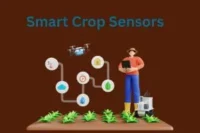The Impact of Agricultural Technology in Rural Australia
Published: 13 Apr 2025
Farming in New South Wales, Australia
New South Wales is one of Australia’s most productive agricultural states, with large-scale production of wheat, cotton, livestock, and horticultural crops. However, farmers in this region face a number of persistent and evolving challenges.

- Climate variability: Severe and prolonged droughts have become increasingly common, affecting crop yields and livestock conditions.
- Water scarcity: Efficient irrigation has become a priority due to declining rainfall and pressure on natural water resources.
- Rising costs: Fertilizer, labor, and machinery costs have steadily increased, squeezing profit margins.
- Labor shortages: Many rural areas struggle to attract and retain workers, particularly during planting and harvest seasons.
Case Example – Jack Turner
Jack Turner is a third-generation wheat and cattle farmer operating near Dubbo, NSW. For years, Jack relied on conventional methods passed down through generations. However, in recent years, he began facing erratic weather patterns and rising costs that threatened the viability of his family farm. During one particularly harsh drought season, his wheat yield dropped by nearly 40%, forcing him to rethink his approach.
So, guys, without wasting time, let’s jump into the article to learn the The Impact of Agricultural Technology in Rural Australia
Introduction of Agricultural Technology
Recognizing these challenges, the Australian government partnered with tech companies and research institutions to promote innovation in agriculture. Several rural tech initiatives were launched to assist farmers in integrating advanced systems into their operations.
Objectives of the initiative:
- Increase productivity and reduce input waste.
- Make agriculture more climate-resilient and water-efficient.
- Support farmers in adopting smart technologies through funding and training.
Technologies introduced:
- Remote sensing and drone surveillance
- Aerial monitoring of fields to detect plant stress, pests, or disease early.
- Thermal and multispectral imagery to track soil health and moisture.
- GPS-guided and autonomous machinery
- Tractors and harvesters equipped with precision navigation systems.
- Reduced overlapping, minimized fuel use, and optimized time in the field.
- IoT-based water and soil management
- Soil moisture sensors that automate irrigation based on real-time data.
- Centralized mobile apps to monitor and control field conditions remotely.
- Data analytics and forecasting tools
- Software to track weather patterns, market trends, and crop performance.
- Farm management systems to guide planting schedules and input levels.
Training and support:
- Local workshops and field demonstrations in collaboration with universities like the University of Sydney and agri-tech companies.
- Access to online resources and helplines for real-time support.
- Subsidies and grants to reduce the financial burden of technology adoption.
Jack’s Transformation
Jack Turner initially hesitated to adopt high-tech solutions. He questioned the return on investment and wasn’t sure if he could manage the complexity. But after attending a workshop hosted by the NSW Department of Primary Industries, he decided to test a few technologies on a small section of his farm.
Steps Jack took:
- Installed IoT soil moisture sensors and an automated irrigation system.
- Introduced a GPS-guided tractor for seeding and fertilizing.
- Began using drone mapping to monitor crop health and identify stress zones.
Improvements observed:
- Water usage dropped by 40% in the test plots during the first season.
- Crop yields improved by over 20% — even during another dry year.
- Fuel and fertilizer costs decreased thanks to targeted application.
- Labor needs reduced significantly with automated fieldwork.
Encouraged by the results, Jack expanded the technologies across his entire farm. His profits stabilized, and his operational efficiency improved. He even began mentoring neighboring farmers and hosting demonstration visits.
Results and Impact
Individual Impact – Jack Turner:
- Improved resilience to climate fluctuations by integrating data-driven farming.
- Achieved higher and more consistent yields despite ongoing dry conditions.
- Reduced his farm’s environmental footprint while improving profitability.
- Named his upgraded operation “ClearSky Farms,” symbolizing transparency and innovation.
Community Impact:
- In Jack’s region, over 50 farmers adopted smart farming practices within two years.
- Drought-affected crop losses were reduced due to timely irrigation and monitoring.
- Increased local employment in agri-tech support and consulting roles.
- Formation of local agri-tech cooperatives to share tools, data, and costs.
Wider Implications of Agricultural Technology in Australia
Why it matters:
- Agriculture is vital to Australia’s economy, contributing over $70 billion annually.
- With growing export demands and extreme climate conditions, sustainable innovation is essential.
- Rural communities must adapt to protect their livelihoods and maintain food production levels.

How agri-tech supports this:
- Precision agriculture improves input efficiency and reduces environmental impact.
- Autonomous and GPS-guided equipment saves time, labor, and fuel.
- IoT and sensors support informed, real-time decisions and automate critical processes.
- Data analytics empower farmers with accurate forecasting and strategic planning.
Key success factors in Australia:
- Strong public-private collaboration between governments, universities, and tech innovators.
- Funding and subsidy schemes to reduce financial barriers.
- Focused training and capacity-building to ensure smooth adoption in rural areas.
References
The references below support the real-world examples and data presented in this article on how agricultural technology is transforming farming in rural Australia. They include sources from government agencies, research institutions, and agricultural innovation programs relevant to the Australian context.
Here Is the online source Regarding The Impact of Agricultural Technology in Rural Australia
Author Name
Tony Sorensen
Australian agricultural R&D and innovation systems

- Be Respectful
- Stay Relevant
- Stay Positive
- True Feedback
- Encourage Discussion
- Avoid Spamming
- No Fake News
- Don't Copy-Paste
- No Personal Attacks

- Be Respectful
- Stay Relevant
- Stay Positive
- True Feedback
- Encourage Discussion
- Avoid Spamming
- No Fake News
- Don't Copy-Paste
- No Personal Attacks





